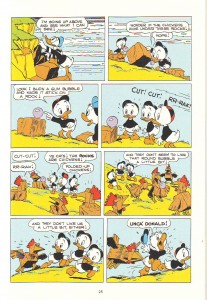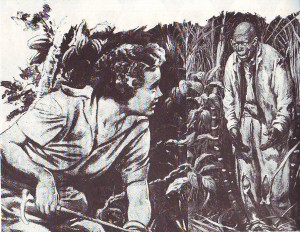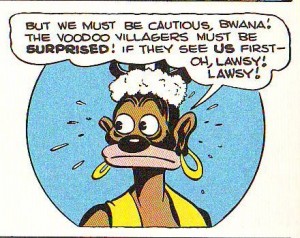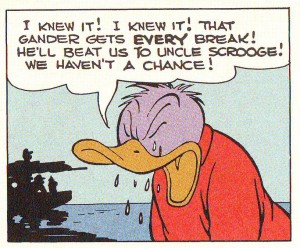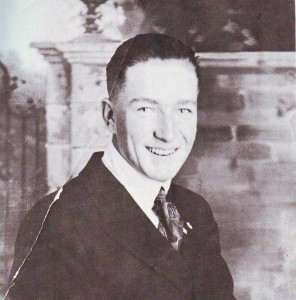Walt Disney’s Donald Duck “Lost in the Andes” by Carl Barks
The book with the title above is the first (the seventh, according to editor and publisher, Gary Groth) of a new Carl Barks Library published by Fantagraphics (the first CBL was published by Another Rainbow). There are a few differences between the two: CBL 1 was published in 30 handsomely made volumes encased in 10 slipcases – CBL 2 will probably also be 30 volumes, but with a more comic booky look (i. e. smaller); color wasn’t completely absent from CBL 1, but it was way above 90 % b & w – not so CBL 2 which will be in color. That last aspect occupied most of the pre-publication discussions about the project on the www. We all know how bad the coloring of the classics has been until recently, but new printing technologies solved said problem. The only obstacle to a good coloring in comics reprints these days is the absolute disrespect for both the material and the readers that most comics publishers always showed. Not so Fanta, right? Well… yes and no…
Only a fool could think that in a colored drawing the color isn’t part of the art. So, how come that we can continue to say that a drawing is by Carl Barks alone when it was colored by someone else? The fact is that we can’t and that’s all good and dandy if the colorist is the original one because those were the creators of said drawing even if we have no idea of what the latter’s name was. In this reprint we do, don’t we?: Rich Tommaso. So, what we’re buying isn’t really “Lost in the Andes” by Carl Barks… what we’re buying is “Lost in the Andes” by Carl Barks and Rich Tommaso.
“Lost in the Andes!” by Carl Barks and an anonymous colorist working at the Western Publishing Production Shop (I can’t believe that no one was curious enough to investigate who these colorists were): Four Color # 223, April 1949.
The Same page by Carl Barks and Rich Tommaso, Walt Disney’s Donald Duck “Lost in the Andes,” 2011.
When there’s no contour line the colors are really the drawing and there’re differences between the original and the recolored page. This can be seen above, but it’s more clear in “Truant Officer Donald” (Walt Disney Comics and Stories # 100, January 1949). In said story’s reprint the shadows in the snow are completely different. Another problem is caused by the absence of the old Ben-Day Dots. Some may think that these were a nuisance, but the dots had a transparency sorely lacking in modern coloring: while the old shadows look like shadows, the new ones look painted on the ground and lack flexibility. Even if mostly true to the original (all the one-pagers were originally published in black and magenta but “Ornaments on the Way” – Four Color # 203 – and “Sleepy Sitters” – Four Color # 223) many of the colors are also too saturated in the reprint version (which is odd because Rich Tommaso said that he toned the colors down), but that’s a problem even in Fantagraphics’ excellent Prince Valiant reprints.
To be blunt: if kitsch is something pretending to be something else this edition is definitely kitsch, but you know what Abraham Moles said: kitsch is the art of hapiness…
All these problems were avoided in the Popeye series. Why did Fantagraphics proceed differently in their CBL project? Beats me, but I can guess: Fanta wants to have its cake and eat it too. They want to produce a collection both for the serious collector and for children. Well, this serious collector is perfectly happy with CBL 1, thank you!…
Another hint suggesting that I’m right is the time period in Carl Barks’ career selected to start this new CBL. Any collector would expect a reprint in chronological order, but no such luck. What we have is a potpourri of longer stories, ten-pagers and one-page gags from December 1948 to August 1949. In this Gary Groth did agree with Barks himself who considered this to be his most and best creative period. Besides he also said that “Lost in the Andes” was his favorite Donald Duck story. I beg to differ: I prefer later, darker, more satirical, Barks, but that’s irrelevant, really, because I would start a CBL where most things usually start: at the beginning. Yet another Barksian coincidence re. the commercial part of the enterprise is the quantity of Christmas stories included in a book that was published just before… Christmas. If you can’t see the irony of this in a Carl Barks book I gather that you don’t know much about his work…
None of this matters much though. The above mentioned potpourri isn’t that bad (I would repeat what was done in CBL 1, but that’s just me) and collectors can always put this tome on the shelf in the seventh place.
To favor interested adult readers and smart inquisitive kids each story has a presentation by a comics critic. The critics are very good. Their texts are interpretations of the stories; convey information (I was pleased to learn about American life during the forties reading Jared Gardner’s comments), and give us close formalist readings that are brilliant: Donald Ault is particularly good at this (his intro is also great if slightly hagiographic; his analysis of “The Crazy Quiz Show” – originaly published in Walt Disney’s Comics and Stories # 99, December 1948 – is an instant classic of comics criticism).
Don’t get me wrong , I love Barks. He’s one of four or five genre mass media artists that I admire… but… is there really a need to whitewash him? Because that’s what we see in the above mentioned comments. This book has its share of racist imagery and the critics don’t hide the fact. The problem is that they make up excuses. Jared Gardner does it commenting “Voodoo Hoodoo” (Four Color # 238, August 1949). To quote him:
[…] our “villain,” Old Foola Zoola [fool Zulu?] is drawn with all the maniacal monstrosity of similarly racist representations of African witch doctors that remained largely unchanged from nineteenth-century cartoons in Puck and Life through Abbott and Costello’s Africa Screams (1949). And yet Foola Zoola’s outrage for the wrongs done to him and his people by Scrooge and his hired thugs is presented as entirely justified.
That’s just the problem: it isn’t presented as justified at all. If it did he wouldn’t be a fool and he wouldn’t be a racist caricature, would he? Also, why are there quotation marks on the word “villain”? That’s what Foola Zoola is, period.
As can be seen below (panel from “Voodoo Hoodoo” in CBL 2; is that a Barks cameo at the window?) Bombie the Zombie was inspired by the above illo drawn by Lee Conrey (American Weekly, May 3, 1942; as published in CBL 1).
Whitewashing, as it were, in another “Voodoo Hoodoo” panel (in CBL 1, this time). Not much of an improvement if you ask me (November 1986). Above: the same panel as published in Fantagraphics’ CBL 2.
Uncle Scrooge may be presented as an impossibly rich miser, but he’s never a villain. Carl Barks (in an interview with Michael Barrier, 1974):
I never thought of Scrooge as I would think of some of the millionaires we have around who have made their money by exploiting other people to a certain extent. I purposely tried to make it look as if Uncle Scrooge made most of his money back in the days before the world got so crowded, back in the days when you could go out in the hills and find the gold.
If Uncle Scrooge is or isn’t a thief is just a matter of perspective. He would be if he exploited white people, but oh, no!, he could never exploit the noble savages because they have no use for their riches. Dorfman and Mattelart saw this perfectly well (in How to Read Donald Duck, Imperialist Ideology in the Disney Comic, 1975 [1971] – translation by David Kunzle):
There they are in their desert tents, their caves, their once flourishing cities, their lonely islands, their forbidden fortresses, and they can never leave them. Congealed in their past-historic, their needs defined in function of this past, these underdeveloped peoples are denied the right to build their own future. Their crowns, their raw materials, their soil, their energy, their jade elephants, their fruit, but above all, their gold, can never be turned to any use. For them the progress which comes from abroad in the form of multiplicity of technological artifacts, is a mere toy. It will never penetrate the crystallized defense of the noble savage, who is forbidden to become civilized. He will never be able to join the Club of the Producers, because he does not even understand that these objects have been produced. He sees them as magic elements, arising from the foreigner’s mind, from his word, his magic wand.
That’s what Francesco Stajano and Leonardo Gori refused to see when they mentioned the people abused by Gladstone (in “Race to the South Seas,” March of Comics # 41, 1949) while failing to mention the stereotyped natives mumbling “Ola eela booka mooka bocko mucka!” and worshipping Uncle Scrooge or Uncle Scrooge’s spats, of all things, or both… The above is also valid to describe the Plain Awfulians in “Lost in the Andes.” Said people is just one in a series of noble savages that Scrooge and Donald meet over the years. Barks had a bucolic sensibility: against superficial interpretations that present Uncle Scroge as an apology of Capitalism, he believed that the earth is the true value and gold is worthless (cf. for instance “The Twenty Four Carat Moon,” Uncle Scrooge # 24, December 1958). These inhabitants of utopia live in a primeval innocence: Donald Duck (at the end of “Lost in the Andes”):
[they get their warmth] […] from their hearts! They had so little of anything, yet they were the happiest people we have ever known!
Stefano Priarone says that “Lost in the Andes” is a satire of conformism. A leftist reading would say that it is a comment on the vulnerability of third world peoples to American mass culture. Both readings are possible and it is also possible that, following Donald’s speech above, there’s no satire at all. All interpretations are ideological, of course… One could expect a Marxist reading from David Kunzle, but here’s what he wrote (Art Journal Vol. 49, No. 2, Summer 1990):
How much real sympathy does Barks show for natives, the victims who through weakness and stupidity, or else innocence and simplicity, become willing accomplices to, indeed the very instruments of, their own dispossession? It is hard to say. The facts that our contempt for Scrooge, the great dispossessor, is mixed with admiration for his energy, that Huey, Dewey and Louie are cast as virtue incarnate, and that Donald himself is a victim (actually, a loser on the winning side) tend to neutralize our sympathy for the foreigner-victims. But their resistance, funny and futile as it so often is, lends them a measure of dignity – and reality.
The star of the show isn’t Uncle Scrooge, though. The star is undoubtedly Donald Duck. Even to Dorfman and Mattelart Donald is a sympathetic character (Carl Barks: interview with Edward Summer, 1975):
Instead of making just a quarrelsome little guy out of him, I made a sympathetic character. He was sometimes a villain, and he was often a real good guy and at all times he was just a blundering person like the average human being, and I think that is one of the reasons people like the duck.
Dorfman and Mattelart (in How to Read Donald Duck – translation by David Kunzle):
We Latin Americans tend to identify more readily with the imperfect Donald, at the mercy of fate or a superior authority, than with Mickey [Mouse], the boss in this world, and Disney’s undercover agent.
David Kunzle (also in How to Read Donald Duck):
Donald Duck […][is] an example of heroic failure, the guy whose constant efforts towards gold and glory are doomed to eternal defeat.
Donald Duck, the eternal loser, becomes purple with envy, in “Race to the South Seas” as published in Walt Disney’s Donald Duck “Lost in the Andes.”
Carl Barks was no ordinary genre creator. He followed some tropes of pulp, but he also had his own formula (Donald Ault cited by Thomas Andrae and Geoffrey Blum in the CBL 1):
Th[e] emphasis on cosmic irony led Barks to create a formula for his ten-page stories: a six-to eight-page buildup of our expectations against mounting probabilities, following by a two-to four-page reversal culminating in the fulfillment of our original expectations, but in a surprising and ironic manner.
[F]our narrative impulses […] inform Barks’ stories. In the order of their complexity, these are: 1) excessive coincidence; 2) conflicts escalating in a chain reaction; 3) events threatening to move beyond control of both the characters and the narrator; and 4) reflection on the narrative processes controlled by Barks himself.
The cosmic irony mentioned above is my favorite Barks’ trait: he was a master satirist. Carl Barks (in an interview with Donald Ault, Thomas Andrae and Stephen Gong, 1975):
I read some of my stories recently and thought, ‘How in the hell did I get away with that?’ I had some really raw cynicism in some of them.
I told it like it is. I told the kids that the bad guys have a little bit of good in them, and the good guys have a lot of bad in them, and that you just couldn’t depend on anything much, that nothing was going to always turn out roses. (Interview with Donald Ault, 1973.)
Readers can attest to that reading and viewing his masterfully paced, written, drawn and designed pages in Walt Disney’s Donald Duck “Lost in the Andes. All this in spite of this edition’s recoloring problems… if these are viewed as problems at all, that is… which I very much doubt…
Carl Barks circa the end of WWI. Photo as published in Carl Barks and the Art of the Comic Book by Michael Barrier, 1981.


